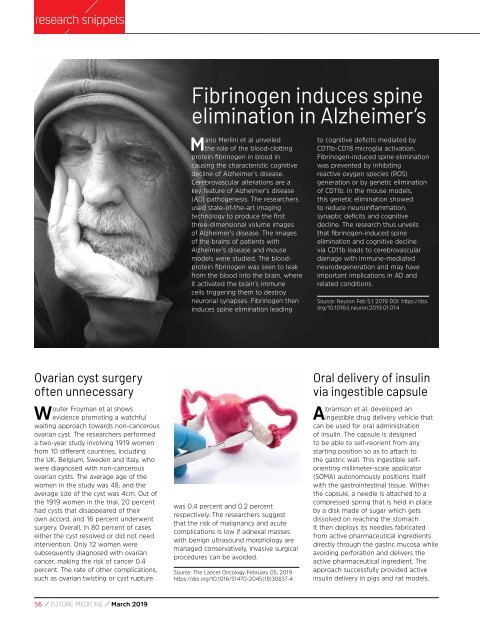March 2019 digital v1
Create successful ePaper yourself
Turn your PDF publications into a flip-book with our unique Google optimized e-Paper software.
esearch snippets<br />
Fibrinogen induces spine<br />
elimination in Alzheimer’s<br />
Mario Merlini et al unveiled<br />
the role of the blood-clotting<br />
protein fibrinogen in blood in<br />
causing the characteristic cognitive<br />
decline of Alzheimer’s disease.<br />
Cerebrovascular alterations are a<br />
key feature of Alzheimer’s disease<br />
(AD) pathogenesis. The researchers<br />
used state-of-the-art imaging<br />
technology to produce the first<br />
three-dimensional volume images<br />
of Alzheimer’s disease. The images<br />
of the brains of patients with<br />
Alzheimer’s disease and mouse<br />
models were studied. The bloodprotein<br />
fibrinogen was seen to leak<br />
from the blood into the brain, where<br />
it activated the brain’s immune<br />
cells triggering them to destroy<br />
neuronal synapses. Fibrinogen then<br />
induces spine elimination leading<br />
to cognitive deficits mediated by<br />
CD11b-CD18 microglia activation.<br />
Fibrinogen-induced spine elimination<br />
was prevented by inhibiting<br />
reactive oxygen species (ROS)<br />
generation or by genetic elimination<br />
of CD11b. In the mouse models,<br />
this genetic elimination showed<br />
to reduce neuroinflammation,<br />
synaptic deficits and cognitive<br />
decline. The research thus unveils<br />
that fibrinogen-induced spine<br />
elimination and cognitive decline<br />
via CD11b leads to cerebrovascular<br />
damage with immune-mediated<br />
neurodegeneration and may have<br />
important implications in AD and<br />
related conditions.<br />
Source: Neuron Feb 5,t <strong>2019</strong> DOI: https://doi.<br />
org/10.1016/j.neuron.<strong>2019</strong>.01.014<br />
Ovarian cyst surgery<br />
often unnecessary<br />
Wouter Froyman et al shows<br />
evidence promoting a watchful<br />
waiting approach towards non-cancerous<br />
ovarian cyst. The researchers performed<br />
a two-year study involving 1919 women<br />
from 10 different countries, including<br />
the UK, Belgium, Sweden and Italy, who<br />
were diagnosed with non-cancerous<br />
ovarian cysts. The average age of the<br />
women in the study was 48, and the<br />
average size of the cyst was 4cm. Out of<br />
the 1919 women in the trial, 20 percent<br />
had cysts that disappeared of their<br />
own accord, and 16 percent underwent<br />
surgery. Overall, in 80 percent of cases<br />
either the cyst resolved or did not need<br />
intervention. Only 12 women were<br />
subsequently diagnosed with ovarian<br />
cancer, making the risk of cancer 0.4<br />
percent. The rate of other complications,<br />
such as ovarian twisting or cyst rupture<br />
was 0.4 percent and 0.2 percent<br />
respectively. The researchers suggest<br />
that the risk of malignancy and acute<br />
complications is low if adnexal masses<br />
with benign ultrasound morphology are<br />
managed conservatively, invasive surgical<br />
procedures can be avoided.<br />
Source: The Lancet Oncology February 05, <strong>2019</strong><br />
https://doi.org/10.1016/S1470-2045(18)30837-4<br />
Oral delivery of insulin<br />
via ingestible capsule<br />
A<br />
bramson et al. developed an<br />
ingestible drug delivery vehicle that<br />
can be used for oral administration<br />
of insulin. The capsule is designed<br />
to be able to self-reorient from any<br />
starting position so as to attach to<br />
the gastric wall. This ingestible selforienting<br />
millimeter-scale applicator<br />
(SOMA) autonomously positions itself<br />
with the gastrointestinal tissue. Within<br />
the capsule, a needle is attached to a<br />
compressed spring that is held in place<br />
by a disk made of sugar which gets<br />
dissolved on reaching the stomach.<br />
It then deploys its needles fabricated<br />
from active pharmaceutical ingredients<br />
directly through the gastric mucosa while<br />
avoiding perforation and delivers the<br />
active pharmaceutical ingredient. The<br />
approach successfully provided active<br />
insulin delivery in pigs and rat models.<br />
56 / FUTURE MEDICINE / <strong>March</strong> <strong>2019</strong>


















